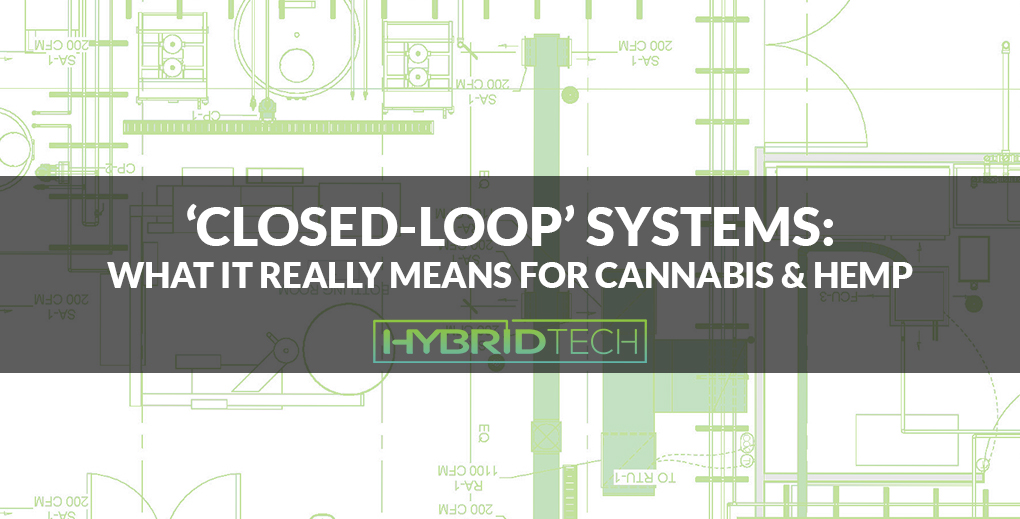
Hybrid Tech Announces Lab Planning & Processing Division for Cannabis and Hemp
September 11, 2020
Connecticut Cannabis Legalization Brings Opportunities
January 30, 2023‘Closed-Loop’ Systems: What it really means for cannabis & hemp
Due to the seemingly endless number of extraction equipment vendors, trying to differentiate each manufacturer or design as superior to another is difficult when ambiguous terms are thrown around as selling points. One of these vague, multi-connotation words is ‘closed-loop.’
The term ‘closed-loop’ can have several meanings when referring to cannabis extraction equipment since the phrase is used in multiple disciplines and industries. The first definition we’ll discuss is more common in other fields and refers to whether the equipment can accomplish continuous and immediate adjustments due to the presence of a feedback loop within the control system. An example of this would be to constantly measure the temperature of a chamber and via system controls automatically adjust the power input to maintain a desired temperature, like a thermostat or a refrigerator in your house. Closed-loop control is continually conscious of the output signal, which is fed back into the controls (Figure 1).

Figure 1. A closed-loop controls system.
A more relevant definition to the cannabis industry and to equipment utilized during extraction is the connotation of ‘closed-loop’ in reference to solvent usage and recycling. This is the type of system or process in which everything you put into it also comes out, yet in a different form. A perfect closed loop for a cannabis extraction system would require only dried cannabis as the input, and the output would then be extracted oil and completely dried, processed biomass (Figure 2). These ideal input/output parameters, however, are not possible for any economically feasible system. While most extraction solvents (CO2, ethanol, etc.) can be recycled throughout the system, usually some solvent is needed to be replaced for what is unavoidably lost during the repetitive extraction process.

Figure 2. A perfect closed solvent loop system.
Conversely, an open-loop extraction system would output cannabis or hemp oil still in solution (like ethanol) or the solvent would be lost to the atmosphere (depressurized butane or CO2).
Last, we’ll touch on a definition used by electricians and fire marshals for classifying spaces used for cannabis processing or extraction. The National Electrical Code (NEC) classifies spaces into two categories: Class I, Divisions 1 (C1D1) and Class 1, Division 2 (C1D2).
A C1D1 space is explained as:
Class I, Division 1 location is a location in which ignitable concentrations of flammable gases, flammable liquid – produced vapors, or combustible liquid – produced vapors can exist under normal operating conditions.
This also applies to cases in which these flammable gases and liquids exist frequently due to repair or maintenance operations. In short, an open-loop system or piece of equipment would classify the surrounding location as a CID1 space due to the exposure of flammable ethanol or butane during normal operating conditions. As a result, special electrical, ventilation, and fire suppression requirements are applied to that space.
A C1D2 space is defined most commonly as:
Class I, Division 2 location is a location in which ignitable concentrations of flammable gases, flammable liquid – produced vapors, or combustible liquid – produced vapors are handled, processed, or used, but in which the liquids, vapors, or gases will normally be confined within closed containers or closed systems from which they can escape only in the case of accidental rupture or breakdown of such containers or systems or in the case of abnormal operation of equipment.
This definition also applies to situations where the normal positive-pressure ventilation fails to control a buildup of flammable gas or liquid vapor. As can be seen in the definition itself, a complete closed-loop system is required for a space to be classified as C1D2. These definitions will have the greatest impact on the design of your facility as they are code enforceable and will require certain systems to be in place before your facility can receive a permit.
As you can see, ‘closed-loop’ can take on different meanings whether we are discussing equipment and systems or the space they operate in. Using an MEP (Mechanical, Electrical, Plumbing) Engineering consultant that is familiar with these code requirements in the context of cannabis will save you time and money by ensuring your facility and equipment are designed to meet state and local regulations.
Hybrid Tech is a leading design-build engineering consultant for cannabis and hemp. No matter the type of structure you are building or the end-product you desire, our team of engineers and PhD chemists will work with you to custom-design your facility from product development and formulation to equipment selection and commissioning.

